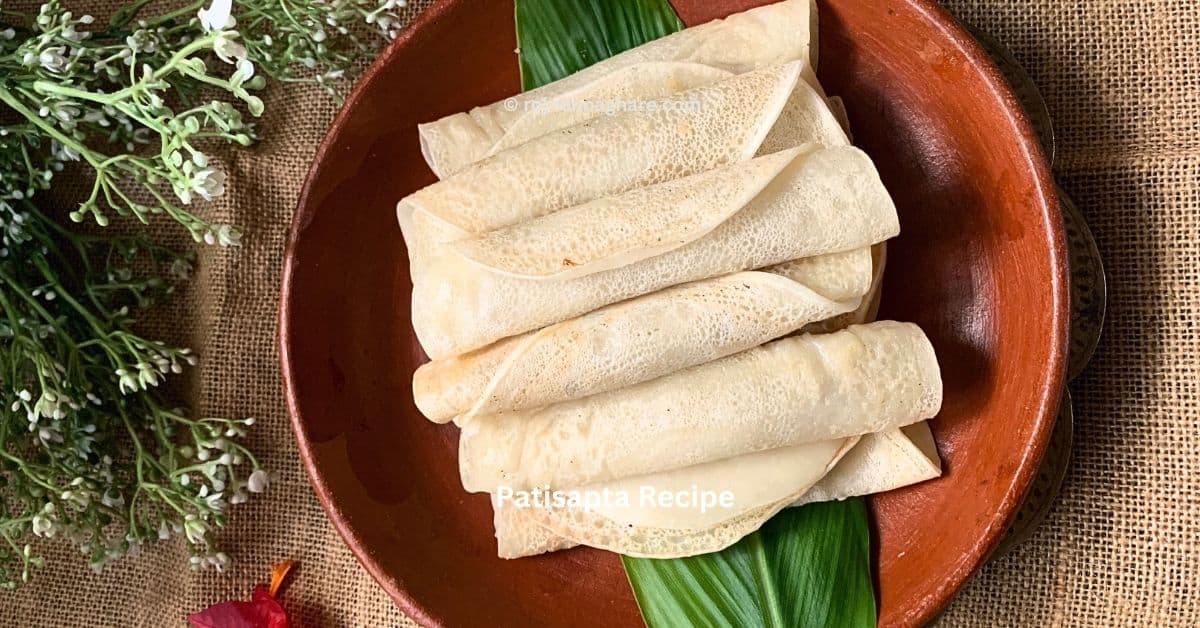Patishapta is one of my favourite pitha in Bengali culture, during the Poush Sankranti festival, which brings warm comfort to the frosty air of January. The day before the festival, my mother would begin preparing pitha, and we, her eager helpers, would be by her side. With practised ease, she’d shape rice flour into various pithas, her nimble fingers working effortlessly. Even as a child, I watched in awe as she crafted the delicate Patishapta. Though I didn’t fully grasp the intricate process back then, I followed her instructions with wide-eyed wonder. The entire house pulsed with the joy of collaboration as everyone gathered to assist her.
On the day of Poush Sankranti morning, I’d bathe before venturing out to burn the Meji ghor (bonfire) or Meramerir Ghor a symbolic farewell to winter. Then came the grand finale: savouring the Patishapta, each bite a testament to my mother’s love and skill.
Today, when Poush Sankranti arrives, I find myself lost in memories. I remember my Boromi (father’s younger sister), who lived nearby in the same city of Guwahati. Every year, she’d visit with his two sons, their presence adding another layer of joy to the festivities. My mother, a whirlwind of activity, would be busy making Patishapta on one hand while keeping everyone entertained on the other.
Now, as the years roll by, I miss those days with a bittersweet pain. The warmth of family, the aroma of freshly made pitha, the laughter echoing in the air – these are the treasures that time cannot steal. They are the essence of Makar Sankranti, a reminder of love, tradition, and the enduring power of home.
Table of Contents
ToggleWhat is Patishapta:
Patishapta is a traditional Bengali sweet, particularly popular in the Indian state of West Bengal and Bangladesh. It is a thin, crepe, filled with a mixture of coconut, khoya (reduced milk), or jaggery. Patishapta is often made during the Makar Sankranti festival.
What is Patishapta Pitha made of:
Patishapta Pitha is made of all-purpose flour/ rice flour combined with semolina, and sugar powder. Mixed with water or milk to make a thick batter. Then the thin crepe is made, and filled with kheer (reduced milk), or coconut and jaggery mixed with reduced milk (khersa).
Serving Suggestion:
Patishapta goes exceptionally well with Kheer / Rabri or Payesh. Before serving you can slightly drizzle date palm jaggery syrup over the rolled Patisapta.
FAQ:
Q: Are there variations of Patishapta?
A: Yes, there are variations of Patishapta with different fillings and ingredients. Some may include variations in the crepe batter, while others experiment with the filling, creating diverse flavours.
Q: Can Patishapta be stored for later consumption?
A: It is always best to consume fresh Patishapta, leftovers can be refrigerated for a short duration. However, the texture may change slightly upon reheating, so it’s good to consume it soon after preparation.
Recipe Card
Patishapta Pitha | Patishapta | Patishapta Pitha Recipe Bengali
Course: Pithe PuliCuisine: Bengali10
servings20
minutes20
minutes120
kcalIngredients
- For Filling:
500 cow milk
1 cup shredded coconut
1/2 cup sugar
- For Patishapta Crepes :
1 cup all-purpose flour
1/4 cup sooji/Samolina
1/2 cup sugar
Pinch of salt
1/2 teaspoon cardamom
1 tablespoon refined oil/ghee
Water as needed
Directions
- How to make filling:
- In a deep-bottomed pan, heat 500 ml of milk, and stir frequently until milk thickens over medium flame.
- Add shredded coconut and sugar and mix until sugar dissolves.
- Grate or crumble date palm jaggery into the milk, adjusting the sweetness according to your preference.
- Continue to simmer until the kheer thickens to your liking and keep aside for cooling.
- How to make Patishapta Crepes:
- In a mixing bowl, combine the all-purpose flour, semolina, sugar, pinch of salt, cardamom powder and refined oil or ghee.
- Gradually add water and mix to form a smooth, lump-free batter. Keep for rest about 30 minutes.
- Heat a non-stick pan and add a few drops of oil or ghee.
- Pour a ladleful of batter onto the pan and spread it in a circular motion to make a thin crepe.
- Cook on medium heat until the edges start to lift. Add a little oil or ghee on the sides.
- Once the crepe is cooked, place a spoonful of coconut or khoya filling in the centre and fold the sides to make a roll. Repeat the process for the remaining batter.
Notes
- Before pouring the batter every time brush the pan with oil/ghee to prevent the crepe from sticking to the surface.
- Adjust the consistency of the batter as needed – it should be pourable but not too thin.




